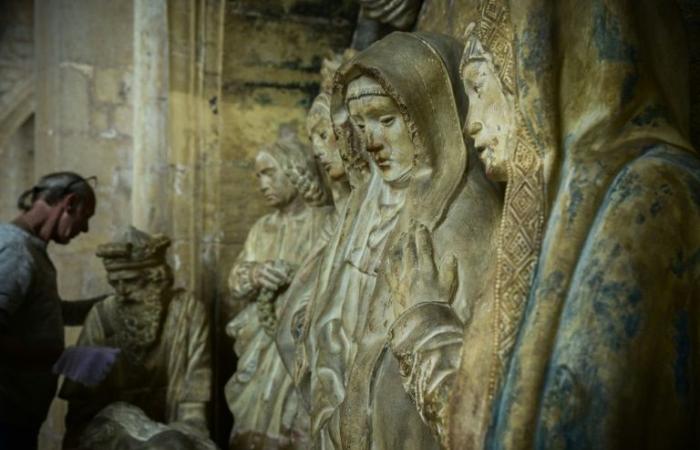“Impressive” copies of Perigord Renaissance statues exhibited at the Metropolitan Museum of Art (MET) in New York have this week arrived at the Château de Biron in Dordogne, thanks to technologies used to reproduce the Lascaux cave.
On the occasion of the European Heritage Days, these facsimiles representing an “Entombment of Christ” surmounted by cherubs were unveiled on Friday, taking the place of the original sculptures in the chapel of this fortress in Périgord, considered the largest castle in Aquitaine (one hectare).
The replicas were installed in a niche under a stone arch, not far from the medieval recumbent figures of two senior members of Gontaut-Biron’s family and a facsimile of a “Pietà” (Virgin holding the body of Christ on her knees), also on display at the MET. This other copy had been put in place in October 2023.
“It completely changes the chapel. It’s a very large chapel, one of the largest castle chapels in the kingdom of France. And since it’s completely stripped down, the fact that the sculptures are coming back gives it back its soul,” Sébastien Cailler, the castle’s manager, rejoices to AFP. “It’s one of humanity’s great treasures.”
These monumental pieces, sculpted in the 16th century by an anonymous artist, were ceded in 1907 by the last Marquis de Biron to John Pierpont Morgan, founder of the JPMorgan bank and president of the MET.
In 1957, a first request for a copy was refused by the American museum because a cast risked damaging the traces of paint still present.
– “Very moving” –
But in 2018, there were no objections: new technologies, used in particular to create the international center for parietal art (Lascaux IV) and its replicas of cave paintings in 2016, make it possible to reproduce the works without touching them, according to the know-how developed by the Atelier des fac-similés du Périgord (AFSP) which made the copies.
Thanks to photogrammetric surveys and 3D machines, these resin replicas imitating the appearance of stone, with the smallest characteristics and defects of the works, were able to be produced in eight months for a budget of 350,000 euros.
Griffith Mann, a curator at the MET, told AFP on Friday that the quality of the copies was “impressive, formidable”, praising in particular the detailed work, from the patina of the colours to the graffiti engraved on the body of Christ.
“Seeing them in their environment is very moving,” he said. “In some situations, objects return to their original place, as they should. But in a situation like this, where there is no conflict over ownership of the object, such a partnership is a very useful way of giving visitors to the castle a glimpse of the original sculptures in their context.”
“These statues, in any case, are better preserved at the MET than here,” says André Barbé, general director of the tourist company Semitour Périgord, which manages the Château de Biron and the prehistoric site of Lascaux. “The facsimile is there for that. That’s exactly the story of Lascaux: let’s preserve the originals but show them to the public.”
Biron Castle, where the new historical series from France Télévisions “Fortune de France” was filmed, welcomed more than 60,000 visitors in 2023.
jed/ppy/ale






